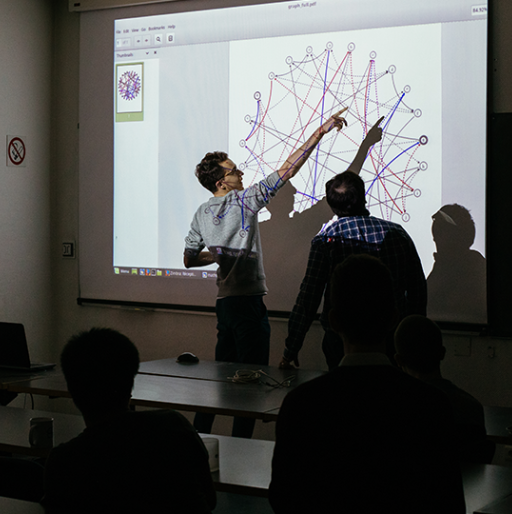
Towards foolproof algorithmics
To design algorithms in number theory (a branch of mathematics dedicated to the study of integers) that are rigorous and efficient over the long term: this is the objective of the new Canari project-team at the Inria Centre at the University of Bordeaux, jointly with the CNRS and created in the wake of the former LFANT project-team. "From a scientific point of view, the first challenge of our research is to develop increasingly secure and efficient algorithms, to be able to rapidly manipulate very large objects (often several gigabytes)", explains Damien Robert, the team's leader. To carry out its mission, the team includes some fifteen permanent researchers, plus doctoral and post-doctoral students.
"Our work also focuses on arithmetic, in particular to develop tools for very precise calculations with numbers comprising thousands of digits after the decimal point, and on the development of solutions to the new challenges posed by the digital society in terms of cryptography", says Damien Robert.
Adapting cryptography to new uses
Because when it comes to cryptography (the science of secret messages), needs are constantly growing... And they go far beyond electronic signatures and encryption, which we all use today - often unknowingly - to authenticate ourselves or to encrypt the information we exchange with others. With the rise of cloud computing and the increasing dissemination of data among different hosts, the Canari team has no shortage of avenues of research: "We are interested, for example, in mathematical techniques such as multiparty computation and homomorphic and functional encryption, which enable programs to be run on encrypted data", explains Damien Robert.
This has obvious benefits, for example in the healthcare field, as the researcher points out: "With certain artificial intelligence programs, it is now possible to train neural networks to analyze confidential and encrypted health data, in order to draw up statistics, while preserving the anonymity of the patients concerned."
And the societal impacts don't stop there... The project team's research will also help secure electronic voting, and reduce the environmental footprint of blockchain, thanks to the design of new mathematical building blocks. Canari's originality lies in the fact that it applies the latest mathematical advances in name theory to cryptography.
Preparing for the quantum computer
Another major challenge: post-quantum cryptography. Canari's objective? To create cryptosystems that cannot be "broken" by future quantum computers, which are far more powerful than our current machines. "To this end, we are developing algorithms for implementing cryptographic systems based on networks or isogenies," explains Damien Robert. With these systems, the key to encrypting information is a randomly constructed path in a gigantic graph.
Some institutions expect their systems to be tamper-proof over the long term," notes the researcher. For example, as part of a call for projects from the American standards body NIST, we are currently collaborating with researchers from the DGA (Direction Générale de l'Armement) in France and ETH Zurich (Swiss Federal Institute of Technology) in Switzerland to create post-quantum signature algorithms."
Widely distribute high-precision software via open source
The tools already designed by Canari researchers are all available as open source. In this way, the team is contributing to most of the worldwide development of open-source software for number-theoretic calculations. This is notably the case with the Pari/GP formal calculation system, created to manipulate abstract mathematical objects, or with Arb, FLINT and MPC, libraries dedicated to interval arithmetic (helping to limit rounding, to propose particularly rigorous results) and very high-precision calculations. Arb is already integrated into calculation software produced by publishers such as Maple and Mathematica.
These programs, developed and maintained by Canari researchers and communities that meet regularly, help to correct results and ensure that there is no loss of precision," emphasizes Damien Robert. In the future, we hope that they can also be increasingly used outside the mathematical community, for analysis purposes."
An ambition that is already taking shape. For example, Canari's high-precision calculation software has just been used for studies in the energy sector (to calculate the optimum placement of wind turbines) and astronomy (to simulate the trajectories of stars and planets). And that's just the beginning!
Find out more
General public:
- Post-quantum cryptography: Inria research shines, Inria, 20/9/2022.
- Quantum cryptography and communication (in french), CEA, 12/2/2021.
- Quand la cryptographie sera quantique (vidéo in french), by Eleni Diamanti, physicist and CNRS Sorbonne Université researcher, Cité des sciences et de l'industrie, 28/1/2020.
For experts:
- Damien Robert, Applications of isogenies between abelian varieties to elliptic curves cryptosystems (vidéo), VaNTAGe, 6/12/2022.
